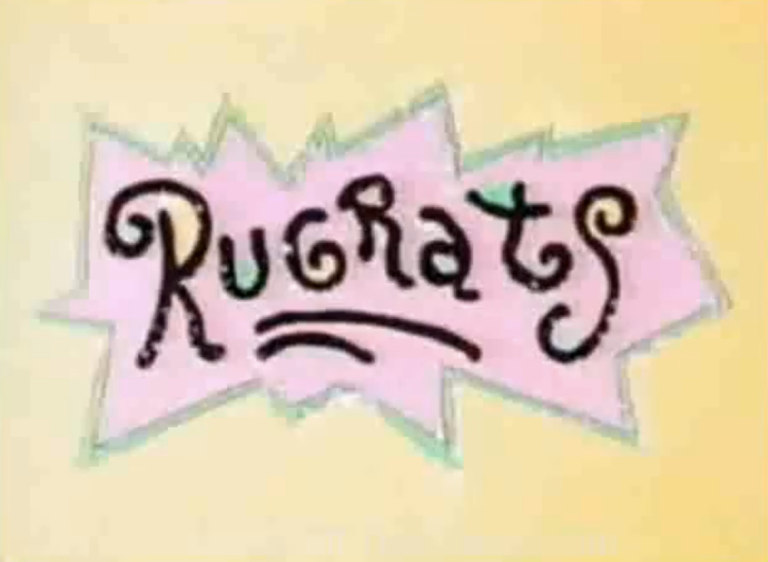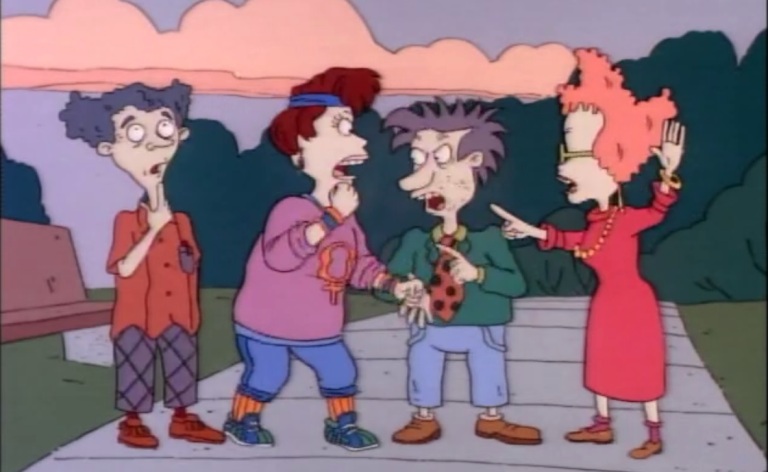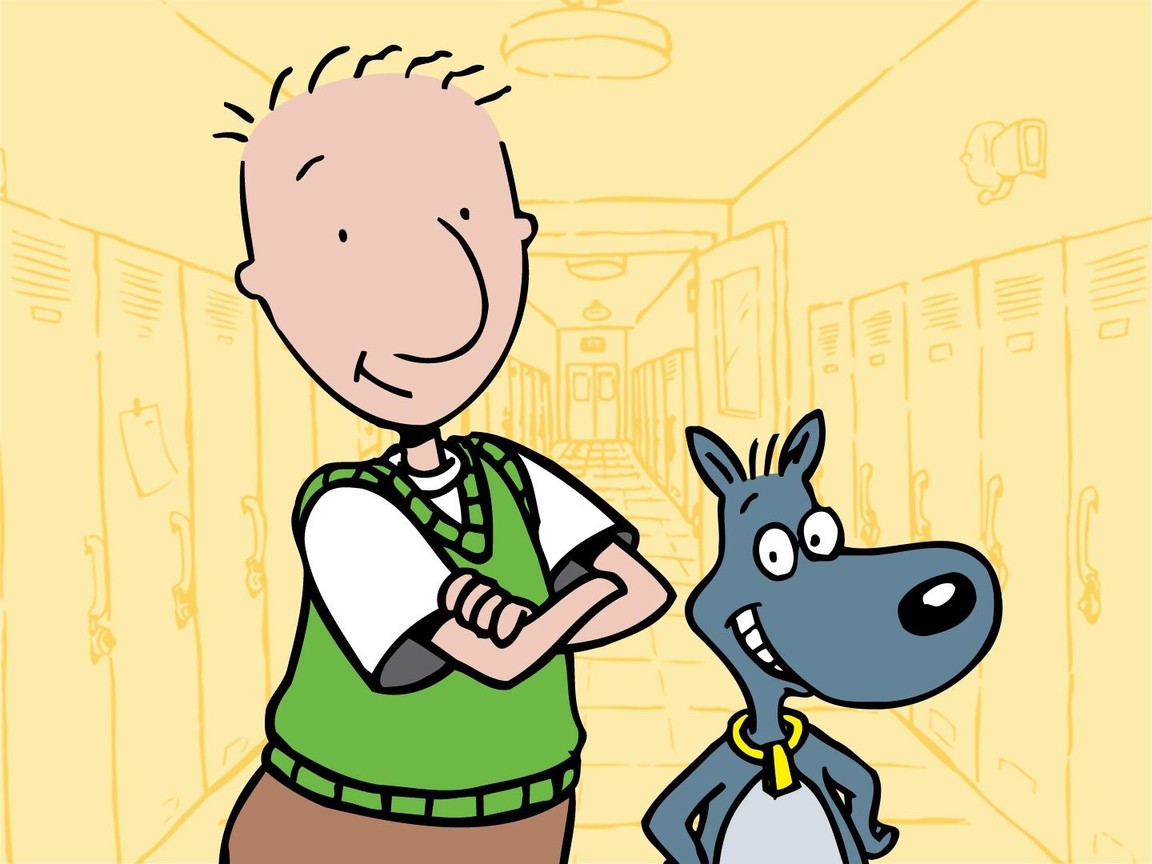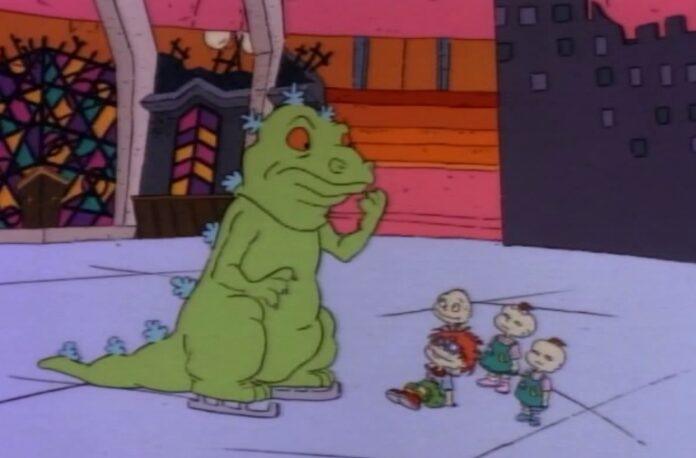Rugrats
Season 2, Episode 10: “Reptar On Ice”/”Family Feud”
Original airdate: November 8, 1992
Abhishek: While the Reptar-heavy first act is more renowned and often considered representative of the Rugrats stories, “Family Feud” intrigued me far more.
Rugrats primarily revolves around the babies, but the very reason these infants come together is due to their parents’ prior relationships.
Stu, Tommy’s dad, was childhood friends with Chas, Chuckie’s dad, and Drew, Angelica’s dad; furthermore, Stu and Drew are brothers.
Howie and Betty, Phil and Lil’s parents, along with Lucy and Randy, Susie’s parents, happen to be neighbors of Stu and Didi.
It’s worth noting that without the parents’ connections, these babies wouldn’t be friends, making it fascinating to explore the parents’ friendships and the potential strains in their relationships.
This episode places a specific emphasis on Stu and Didi’s interactions with Howie and Betty.
I must confess that my memory of Howie and Betty DeVille is somewhat hazy, but they undeniably form an unusual couple (as evidenced by naming their children Phil and Lil DeVille).
They are polar opposites, with Betty being strong-willed and enthusiastic while Howie tends to be meek and reserved.
This leads one to question why they would be friends with the absent-minded Stu and the scholarly Didi.
When a charades game sparks a quarrel between the couples, their children find themselves separated, prompting them to work towards reuniting their parents so they can all play together once more.
While the episode predominantly shifts its focus towards the adults, the central question it raised for me is what the babies would forfeit if this friendship were to fade.
In my perspective, Rugrats revolved around Tommy’s escapades with Chuckie, often in collaboration with or opposition from Angelica. Phil and Lil, though consistently part of the group, contributed relatively little to the unfolding adventures.
It’s relatively straightforward to understand where Tommy, the daring hero, Chuckie, the anxious sidekick, and Angelica, the formidable antagonist, fit into the narrative. However, the twins often appeared to keep to themselves.
Even in “Family Feud,” where they take on the roles of the second and third protagonists alongside Tommy, they still struggle to distinguish themselves as distinct characters.
If, for instance, Tommy were to spend time with new friends Bill and Jill the following week, would he even take notice? Rugrats suggests that these friendships persist as the babies grow up (or become All Grown Up!), but in reality, it remains uncertain why these bonds would endure once Tommy and his companions explore connections beyond their playpen.
Sidant: I believe one of the most remarkable achievements of Rugrats as a show is its ability to portray the lives of babies without condescending to their perspectives.
The motives of the babies are straightforward, and their reasoning is no more or less valid than that of their parents.
Also Read: Roundtable Review: The Green Hornet (1966), “Corpse of the Year” Parts One and Two

In fact, in “Family Feud,” it’s the adults who are consistently in the wrong, leading to Chas reprimanding them towards the end of the episode.
Tommy’s remarkably youthful idealism, in particular, offers a refreshing contrast to the complex, often realistically depicted world of the parents.
This idealism is prominently showcased in Tommy’s “a world where no one fights” speech in “Family Feud,” but it’s also evident in “Reptar on Ice.”
Angelica initially taunts Tommy by suggesting he can’t have Reptar’s cereal, and then she elaborates on how Reptar met his demise because he’s a dinosaur who “got hit on the head by something called a comet,” as she puts it.
However, rather than allowing Tommy to sink into despair and mourn for Reptar, Chuckie, Phil, and Lil assist him in reaching a different conclusion: Reptar is merely hiding.
Their hypothesis gains some support when they discover a lizard in the backyard, which they believe might be one of Reptar’s offspring. (Well, it’s not entirely implausible!)
It’s regrettable that “Reptar on Ice” doesn’t delve deeper into its themes.
A significant portion of its runtime is dedicated to the outlandish ice-skating musical performance, with Tommy and his friends on a mission to reunite Baby Reptar with his “parent” (who, in reality, is a person in a suit).
However, the unfortunate incident that allows Tommy and the gang to step onto the ice initially foreshadows the central conflict of “Family Feud.”
Therefore, when viewed as a complete half-hour episode, it’s not a complete disappointment.
As Andrew points out, “Family Feud” is so compelling that it easily outshines “Reptar on Ice” and would likely overshadow anything that came before it.
Combining a light-hearted musical with a profound exploration of the friendship dynamics among the main characters is actually a rather appealing concept.
Astha: One aspect of Rugrats that has always stood out to me, especially now as an adult, is the show’s clever satirical take on the parenting culture prevalent in the ’90s and continuing into the present day.
The character of Dr. Lipschitz, along with Didi’s intense admiration for him, serves as a blatant parody of Dr. Spock’s influence over parenting decisions for the past few decades.
Didi’s desire for the kids to be fans of “a nice animal” rather than Reptar struck me as particularly amusing, as it reminded me of today’s emphasis on political correctness and the constant concerns of modern parents.
The moments of satire and tongue-in-cheek lines aimed at parents who find themselves watching the show with their children were the strongest elements of “Reptar on Ice.”
This is likely because the plot revolves around something universally disliked by parents, like “Blankety Blank on Ice,” which provides ample opportunities to poke fun at parenting techniques.
Much like Andrew and Cameron, I found the second episode more appealing than the first.
I reside in a town where people tend to maintain friendships with the same individuals they were friends with in first grade, which often extends to their parents as well.
Some parents may have connected through birthing classes or daycare drop-offs, while others might not have met until the first day of after-school pickup or PTA meetings.
Nevertheless, they still find themselves sharing wine nights and embarking on multifamily vacations two decades later because it’s the simplest thing to do in a small town.
Since parents often remain friends due to their kids, irrespective of whether their personalities mesh or clash, I can relate to an episode like “Family Feud.”
It’s easy to understand how a minor incident between friends can escalate into a days-long feud, exposing all the ideological differences and widening the gap without anyone realizing the impact it has on the children.

I concur that Phil and Lil appear to be less central to the group compared to the other kids.
However, within the context of this episode, their relative importance—or lack thereof—serves a purpose.
Even though they could be swapped out with almost any other pair of kids from the neighborhood, the fact remains that Tommy and Chuckie’s unwavering dedication to continuing their playtime together takes precedence.
This highlights the significance of viewing the feud through the perspective of the babies rather than through the lens of the parents.
It serves as a compelling storytelling and character development tool, going beyond merely framing the show in this manner because it was a children’s cartoon that aired on Nickelodeon and was targeted at kids under the age of eight.
Simran: If we’re going to poke fun at parents with a penchant for rhyming names, Andrew, let’s not forget Lou Pickles and his choice of Stu and Drew for his sons. It’s a wonder Tommy isn’t a boy named Sue.
It’s safe to say that Rugrats was not only the most successful Nicktoon but also one of the most successful Nickelodeon original programs.
Only SpongeBob SquarePants, which eventually surpassed Rugrats in terms of the network’s all-time episode count, could possibly rival its success.
Rugrats graced the airwaves for nearly 13 years, garnered four Emmy Awards, and even gave rise to a spin-off series and three theatrical movies.
To put it in perspective: Rugrats made its debut before I entered junior high and aired its final new episode a year after I graduated from college.
For a show that captivated multiple generations of Nick viewers, it seems, on paper, like it shouldn’t have worked at all.
Its central characters are babies, and its supporting cast consists of parents—two age groups that Nickelodeon’s core demographic of adolescents and young teens typically spends most of their waking hours trying to distance themselves from.
Nearly all of the network’s other content, both animated and live-action, adhered to either the template of Rugrats‘ contemporary shows, depicting the everyday lives of kids around the same age, like Doug, or plunging into the depths of surreal weirdness, like Ren and Stimpy.
So, how did a show with no obvious counterpart for adolescent viewers to connect with manage to resonate? I believe the worldview that Cameron described, positioned somewhere between the babies’ unadulterated optimism and the adults’ perplexed pragmatism, is a significant factor.
The babies can wholeheartedly embrace their sources of amusement, such as Reptar, and allow it to sweep them into adventures with minimal prodding.
This aspect is refreshing for anyone in the process of navigating the more complex social pressures and cultural cues of young adulthood.
Conversely, characters like Stu, Didi, Betty, and the others feel like genuine parents.
They are often oblivious, yet consistently well-intentioned, and when push comes to shove, as seen in “Family Feud,” they can even display competence.
Kids can laugh at them and perhaps, on a subconscious level, develop a bit of empathy for the adults in their own lives.
Doug
Season 2, Episode 2: “Doug’s Got No Gift”/”Doug vs. the Klotzoid Zombies″
Original airdate: September 20, 1992
Abhishek:
There’s a valid question to consider regarding the reliability of the narrator in Doug.
Clearly, Doug‘s fantasies, including the Quailman stories like the one in “Doug vs. the Klotzoid Zombies,” are portrayed from Doug’s perspective, but it’s uncertain how much of the “reality” is also shaped by Doug as the narrative character.

The most notable example of this is Roger’s actions between these two stories.
Throughout the series, Roger is depicted as both Doug’s personal rival and a general bully, and this characterization is evident in the second half of “Doug’s Got No Gift.”
In that episode, Roger mocks Doug’s gift for Patti both before and after she opens it, even as the other partygoers appreciate the usefulness of the towel rack.
However, in “Doug vs. the Klotzoid Zombies,” Doug envisions Roger taking his bullying behavior to an extreme by turning all of Doug’s friends into zombies.
In reality, Roger is actually planning a surprise party for Doug, although it’s the least efficient surprise party where everyone assumes Doug will show up uninvited out of jealousy.
While it’s not implausible that Roger, as depicted in “Doug’s Got No Gift,” would attend a surprise party for Doug, as he did attend Patti’s birthday party despite their somewhat unfriendly relationship, it’s hard to imagine the same character going on to throw a surprise party for Doug in “Doug vs. The Klotzoid Zombies.”
Is it possible that, given that we are observing all events through Doug’s perspective, even in “reality,” Doug has created a version of Roger who is far more cruel than he actually is?
This raises intriguing questions about how these episodes would differ if seen through Roger’s eyes and why Skeeter wasn’t the one organizing Doug’s party.
Sidant: These two Doug episodes provide a good representation of the show’s overall style.
“Doug’s Got No Gift” follows a fairly standard plot where Doug spends all his gift money intended for Patti on video games, then struggles as he creates a “towel rack” for her and faces scrutiny from his peers for going against the norm.
In contrast, “Doug vs. the Klotzoid Zombies” delves into the extreme end of Doug’s daydreams. Left in the dark about why his friends are suddenly hanging out with Roger, Doug conjures up a parallel situation involving his superhero alter ego, Quailman.
Andrew touches on the show’s narrative skew, which is fitting since Doug frequently exhibits an overactive imagination, as seen prominently in these two episodes.
This trait is shared with J.D. on Scrubs, and Myles McNutt has discussed J.D.’s fantasies in various contexts as he covered the show for The A.V. Club’s TV Club Classic series.
The fantasies and realities in “Got No Gift” are intricately intertwined; it’s not coincidental that Patti asks Doug to sign his gift with his initials, just like in the arcade game.
The show suggests that one of the concerns that begin to weigh on kids as they grow older is how to make a lasting impact on the world before they pass away.
A significant and rewarding way to leave a mark is through hard work (achieving a high score in a ’90s arcade game is indeed a serious matter, TRUST ME ON THIS).
As a concluding remark, even though I wasn’t really a Nickelodeon enthusiast during my childhood—I leaned more towards Disney Channel, as it had been part of my parents’ cable package long before it became a basic cable network—I feel like I emerged from the womb humming the Doug theme song, and I’m perfectly fine with that.
Among all the shows and theme songs that will be discussed in this roundtable, the only one that even comes close to evoking my childhood memories is probably Clarissa explains it all.
This isn’t surprising, considering that it shares a similar visual style with the Doug opening, which still resonates with me.
Astha: In high school, we had an annual week of fun and competitions known as “Spirit Week,” similar to many other schools.
It involved daily themes that required dressing up to earn points for your grade. During TV Week in my junior year, two of my friends dressed up as Patti Mayonnaise and Quailman with remarkable accuracy, and they did so completely unironically.

My friends and I loved Doug when it originally aired, and we still cherish Doug today, with no signs of that changing.
Doug is timeless because the experiences of adolescence, which can turn you inside out, remain timeless.
Having crushes, dealing with insecurities, having fantasies about those insecurities, aspiring for popularity, and having best friends to support you through it all are hallmarks of the tween and teen years.
Unlike Rugrats, Doug‘s target audience aligns perfectly with the show’s characters.
The problems are so straightforward and relatable that everyone understands where Doug is coming from, yet they can also laugh at the comical things he thinks and does when faced with a dilemma.
Doug goes to the mall, gets engrossed in an arcade game, spends all the money he was supposed to use for his crush, makes her a gift, and then completely FREAKS OUT, experiencing anxiety sweats that you might associate with someone about to go skydiving for the first time.
It’s an exaggerated outcome, but it’s also something that anyone and everyone can relate to in some way.
Quailman was undoubtedly the standout element of Doug, to the extent that I have to commend the show’s writers for not seizing every opportunity to incorporate him in every episode.
At the very least, Doug’s superhero alter ego was a crowd-pleaser, and at most, it served as an allegory for every child’s inner celebrity, something we all aspired to be.
Quailman is a natural extension of a toddler wrapping a sheet around themselves and pretending to be a superhero.
Teenagers also yearn to be superheroes, but they would pursue different feats at the age of 13 instead of six.
One intriguing aspect of Doug is that it already operates in a somewhat alternate reality, with one of the prime examples being his best friend, who happens to have a lovely shade of blue skin.
Already one step removed from the real world, Quailman adds an extra layer of fantasy to an already surreal realm.
Simran: An 11-year-old kid in 1992 who resides in a nondescript suburb, has a massive crush on a classmate, and mostly lives inside his own head.
Nope, absolutely nothing here for me to relate to.
You’ve all done a commendable job discussing the episode and the series, so I’d like to briefly shift our focus to Billy West, who lent his voice to both Doug and Roger.
Today, he’s one of the most renowned voice actors in the industry, largely thanks to his portrayal of a significant portion of the characters on Futurama.
Even in the early ’90s, his work on Doug was somewhat overshadowed by the much flashier roles he played in Ren and Stimpy.
However, West is just as vital in bringing Doug Funnie to life as series creator Jim Jenkins.
His performance bears similarities to his work as Philip J. Fry; although Doug isn’t nearly as dimwitted as Fry, both characters are defined by their everyman qualities.
Doug is such an exceptionally unremarkable individual that, even in his daydreams, his superhero persona is based on a mundane, primarily land-dwelling bird, and he saves the day through the power of beets.
He’s incredibly reserved, yet like all adolescents, his emotions are on a hair trigger.
You can discern exactly what’s transpiring within Doug’s mind and heart, even if Doug himself doesn’t fully understand or cannot articulate it.
Instead of aiming for broad laughs, West imbues every moment with maximum humanity, whether it’s awkward or affable.
Creating a character who is relentlessly ordinary yet distinctive and nuanced enough to carry nearly an entire series—given that Doug serves as the narrator and typically the sole point of view character, his voice propels the majority of each 11-minute episode—is a remarkable achievement.
Also Read: Roundtable Review: Shazam!, “Thou Shall Not Kill” and The Secrets of Isis, “Spots of Leopard”


